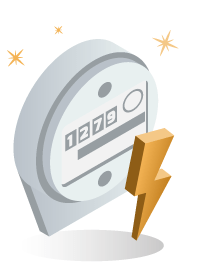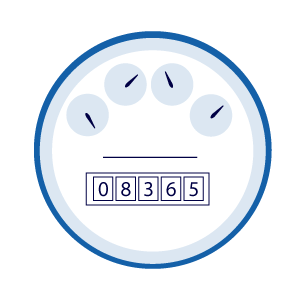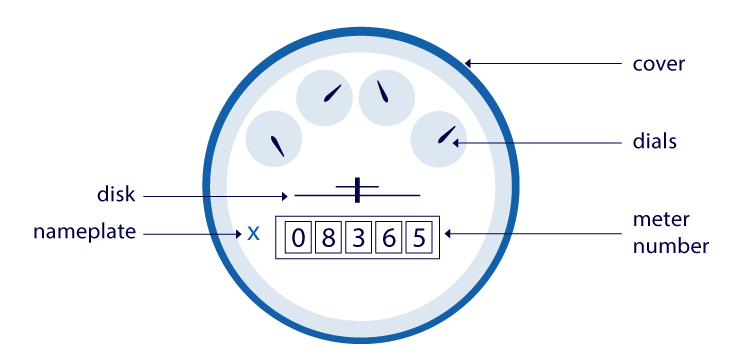10 Things to Know About Your Electric Meter
Your electric meter works for you constantly, but how much do you know about it? Swipe (or scroll) down to know the details on analog and smart electricity meters, how they track energy consumption, where the meter number is located for electric meter readings, the utility company's responsibility for them, and what to do when changing electricity providers (nationally) or switching electric providers in Texas.
What is an electric meter?
An electric meter is a device that measures the consumption of electricity used by your household as it passes into your home. Typically it is installed at the point where the power lines enter your building.
Like the mileage display in your car that shows you the total distance your car has traveled, the electric meter displays the total amount of power that has been used since it was set, and works constantly.
Electricity meters measure energy consumption in kilowatt-hours (kWh). To find out how much electricity you have consumed within a given time period, you must take two readings and subtract the second reading from the first.
While different types of meters exist, they all perform the same function and include the same basic components:
- A unique meter number that is used to identify your consumption
- A display of total electricity consumption

Types of electric meters
There are two main types of electric meters used by most utilities: electromechanical meters and automated ("smart") meters. However, Americans who install microgeneration capacity must install a third type of meter, a bi-directional meter. Check out our guide for more information about different types of meters.
Meter readings : What is a meter number on my electricity meter?
The electric meter that is connected to your home is given a unique number so that your consumption can be identified and billed correctly. You will need to indicate your meter number when you submit a meter reading to your Transmission/Distribution Service Provider (TDSP - also known as your electric utility). This is not the same as the ESI ID#, which is used to localize your meter number, and link your consumption to your meter number.

Meter readings : Where can I find my meter number on my electricity meter?
You will find the meter number on the face of your electricity meter. On a digital meter the meter number is found below the consumption screen.
The meter number on an analog meter is found at the bottom of the electricity meter. In the meter illustration, the meter number is 08365.
Moving to Texas or already living there? Texas residents have options! The ESID meter number is on the meter face or use the Utility Choice ESID lookup by entering an address. Living in deregulated electric zones, a majority of Texans enjoy the competition between +70 providers and can choose electricity plans that use 100% renewable energy, have rate type options, or annual summer energy rate freezes!
How do electromechanical meters work?
Electromechanical meters contain the following components:

- A plastic or glass cover. The cover is sealed so as to reduce the possibility that it can be damaged or tampered with
- Register
- Nameplate
- The unique number for the particular meter
- A disk that turns as power is consumed
- Dials that indicate the total amount of power consumed
Electromechanical induction meters are the most common type of electricity meters currently used the US. They contain an electrically conductive, non-magnetic metal disk that rotates at a speed proportional to the amount of electricity consumed.
- The disk is propelled by the interaction of the magnetic fields produced by two electromagnets surrounding the disks: one that is powered by the power being supplied from the incoming power lines, and the other by the current being demanded by the building's electrical circuits.
- The rotation of the disk is slowed by two permanent magnets that exert a proportional opposing force.
- The numbers on the dial turn as the disk rotates, keeping a continuous tab on total energy consumed.
How do automated smart meters work?
Automated meters (or "smart" meters) work in a similar manner to traditional electromechanical meters, but they also contain a battery and a communication chip. This communication chip sends meter reading data by radio signal to a mobile collector (and rests dormant between these times). This meter reading information is sent to the electricity utility several times of day, through the power lines, or by radio frequency or cellular networks. The utility sends customer consumption information to their energy supplier for billing.
Did you know? The battery in the communication chip in automated meters is designed to last for 15 to 20 years! The communication chip (which is sometimes called an Encoder, Receiver, Transmitter – or ERT – device) operates at the same radio frequency as many cordless phones, but is designed not to interfere with other devices (it will automatically switch to another frequency if it does detect interference).
Why use a smart electric meter?
A smart meter allows your energy provider to determine not just how much electricity you use, but also when you consume it. A traditional automatic meter reading (AMR) tracks your electricity usage, against which your utility company applies an average price for the previous month in order to determine your bill.

Electricity prices vary throughout the day, spiking in periods of high demand, and falling dramatically during periods of low demand - like during the night. Having a smart meter has the advantage of energy consumption accurracy versus a blanket average cost.
As electricity markets become deregulated, companies have searched for better ways of pricing the electricity they provide, in order to charge consumers for the electricity that they use and when they use it. Additionally, because smart meters can be read remotely, electricity and gas companies see them as a way to save money in operating and labor costs. While smart meters do not in themselves constitute a "smart grid," they form an integral part of one.
As such, smart meters can help you save money every month if you are able to consume during off-peak periods (or conversely, end up costing you more).
Living in Texas? Check out our in-depth guide to how smart meters affect your bill
Bi-directional meters
All microgeneration owners must have bi-directional meters installed. These meters measure the flow of electricity that is used by the buildings onto which they are installed, as well as the flow of power that is produced. In other words, they can measure electricity flow in two directions: used energy and produced energy.
There are two types of bi-directional meters: bi-directional cumulative meters and bi-directional interval meters. Both meters essentially work in the same way, but an interval meter makes readings at defined intervals (e.g. every 30 minutes), whereas a cumulative meter does not.
Who owns the electric meter?
Your utility owns the meter on your house. They are responsible for installing, maintaining, and reading your meter. Your meter is sealed and tampering with it is a prosecutable crime (not to mention highly dangerous).
If you would like to have your meter moved or changed, you must contact your utility directly to see if this is possible.
How do I take an electric meter reading?
If you have a smart meter, your information is sent directly to your utility, so you don't technically have to take your meter reading. That being said, it is a good idea to know how much power you are consuming, regardless of what type of meter you have.
Utility companies and electricity providers enable many customers to access their own data collected by smart meters. Reach out to your utility or provider to get online access and start understanding your usage habits!
How to take an electromechanical (analog) meter reading
Electromechanical meters display electricity consumption on a series of dials. To take your meter reading, look at the numbers from left to right, reading the number when the dial is directly on the number, or rounding to the lowest number when it is between two numbers.
Taking a smart meter reading
Getting a smart meter reading is even more straightforward: the LCD screen will display the total kWh consumption as it changes.
Find out more about reading your electricity meter in our guide.
How to take a bi-directional meter reading
A bi-directional meter has two displays: kWh received and kWh delivered. The total kWh will be displayed for both directions. Electricity received will be accompanied with the code "01", and electricity delivered with the code "46". It may display 888 between readings, which is a segment test.
How do I know if my electric meter is accurate?
All meter types and models are tested extensively by your utility before they are deployed for widespread use in your community.
Electromechanic meters have a lifespan of about 30 years. Smart meters have a lifespan of 15 to 20 years but may need to be serviced from time to time before they are eventually replaced. Your utility is also responsible for maintaining and servicing your electricity meter.
Electric meter safety
Some consumers have raised concerns about the safety of smart meters, and the effects the RF (low-energy) radiation they emit.
The American Cancer Society says that it would be nearly impossible to conduct a study to prove or disprove a link between living in a house with smart meters and cancer because people have so many sources of exposure to RF and the level of exposure from this source is so small
The amount of radiation exposure from a smart meter is much less than a standard smart phone, for example.
Studies have also been performed to determine whether radiation from smart meters could interfere with electronic medical devices, such as a pacemaker. It has not been proven that smart meters interfere with these types of devices.
Who do I call if my electric meter doesn't work?
Your utility owns your meter and is responsible for maintaining it. If you think your meter isn't working, call your utility's customer service number to find out more. Please note that in Texas you may need to first call your retail electric provider if you have a concern with your meter.
Tampering with an electric meter by stopping or slowing
Tampering with your meter is illegaland can be extremely dangerous. If you attempt to slow or stop your meter, your electricity connection may be disconnected and you will have to pay for all of the power you have used. You may also pay additional penalties for tampering. You could also be charged with committing an offense.
We do not condone tampering with your meter. You should contact your electric utility and the police if you think that your (or a neighbor's) meter has been tampered with.
Slowing a meter with a magnet
It is possible to slow the speed of the rotation of the disk in an electromechanic meter by attaching powerful magnets to the outside of the meter. The magnets can interrupt the interaction of the magnetic fields within the meter and cause the disk to slow. It is not possible to stop the meter from moving altogether with this method.
Stopping a meter with a needle
Some people have stopped their meter's disk from flowing by piercing a hole in the meter (through the cover) and placing a needle or a piece of card in the meter. This method of tampering is more easily detected as it damages the meter.
What happens to my electric meter when I move?
The electricity meter on your home will not move or change if you move. You should notify your electricity supplier in advance of an upcoming move. A representative from your electricity utility may need to come to your house for a final meter reading, or you may need to phone in the final meter reading yourself.
Find out more about how to get your electricity service started when you move
What happens to my electric meter if I switch energy providers?
Your utility remains the same even when you switch providers. Nothing will happen to your meter if you decide to change energy suppliers. Your power supply should not be interrupted when you make the switch. Find out more about how to your energy supply options.